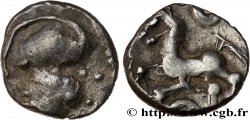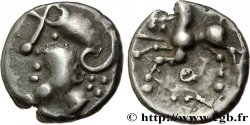bga_175443 - EDUENS, ÆDUI (BIBRACTE, Area of the Mont-Beuvray) Denier à la tête casquée, stylisé
Not available.
Item sold on our e-shop (2010)
Price : 60.00 €
Item sold on our e-shop (2010)
Price : 60.00 €
Type : Denier à la tête casquée, stylisé
Date: c. 80-50 AC.
Mint name / Town : Autun (71)
Metal : silver
Diameter : 15,5 mm
Orientation dies : 3 h.
Weight : 1,37 g.
Coments on the condition:
Denier sur un flan très large mais fin, avec des manques en périphérie. Gravure très stylisée et grossière. Patine hétérogène, presque enganguée au revers
Catalogue references :
Obverse
Obverse legend : ANÉPIGRAPHE.
Obverse description : Tête casquée à gauche ; derrière, croix formée de quatre globules ; grènetis.
Reverse
Reverse legend : ANÉPIGRAPHE.
Reverse description : Cheval libre galopant à gauche ; un annelet pointé au-dessus et un autre entre les jambes ; un timon devant.
Commentary
Ce denier bien particulier appartient à la classe II “à l'effigie stylisée” du Nouvel Atlas. Si les monnaies DT. 3188 et 3189 correspondent assez peu à cette description (mais semblent plus proches des deux deniers précédents DT. 3186 et 3187), la monnaie DT. 3190 est en revanche exactement du même type que le denier proposé ici.








 Report a mistake
Report a mistake Print the page
Print the page Share my selection
Share my selection Ask a question
Ask a question Consign / sell
Consign / sell
 Full data
Full data









